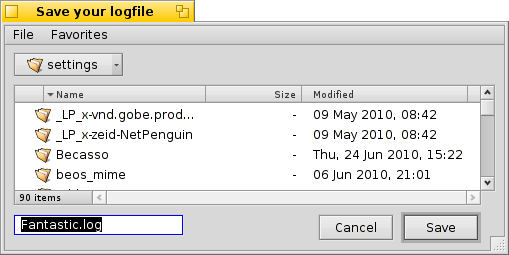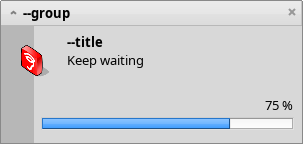 Applicazioni su riga di comando specifiche per Haiku
Applicazioni su riga di comando specifiche per Haiku
| Localita: | /boot/system/bin/ /boot/system/non-packaged/bin/ ~/config/bin/ ~/config/non-packaged/bin/ |
All commandline applications shipped with Haiku are in /boot/system/bin/. Your own or additionally installed commandline apps will appear there as well, or in ~/config/bin/, when installed from a .hpkg package. Otherwise you can put them into /boot/system/non-packaged/bin/ or ~/config/non-packaged/bin/. All these locations are part of the PATH variable and are therefore automatically found.
The following isn't an exhaustive list of all Haiku-specific CLI apps, it serves just to highlight a few of the most useful to give you a taste. Feel encouraged to explore what's in the bin/ folders on your own a bit. Executing an app with the parameter --help shows the usage of the command and all its various options.
 Correlati agli attributi: listattr, catattr, addattr, rmattr, copyattr
Correlati agli attributi: listattr, catattr, addattr, rmattr, copyattr
Questi comandi servono per visualizzare, leggere, aggiungere o rimuovere attributi dai file.
È importante ricordare che questi metadati sono attualmente supportati soltanto dai volumi formattati in BFS, spostare questi file su un altro filesystem eliminerà tutti gli attributi.
Tutti questi comandi sono descritti nel capitolo Gli attributi nel Terminale.
 Correlati all'indice: lsindex, mkindex, reindex, rmindex
Correlati all'indice: lsindex, mkindex, reindex, rmindex
Con questi comandi è possibile visualizzare, creare, reindicizzare e rimuovere attributi dall'indice del BFS.
Ogni volume ha il proprio indice, è utile tenerlo a mente quando si copia un file da un volume all'altro.
Questi comandi sono descritti nel capitolo L'indice del filesystem.
 Relating to package management: package, pkgman
Relating to package management: package, pkgman
The package command is used to manage HPKG packages. Have a look at the article Installing applications to learn the very basics. Usually the tool haikuporter is used to automatically create packages from so-called recipes.
pkgman is used to search, install, update and uninstall packages. Package repositories can be added, dropped and their package lists refreshed. A special kind of update is invoked with the parameter full-sync: it is more aggressive and also downgrades or removes packages, if necessary.
For more details on a parameter, append "--help", e.g. pkgman search --help
 Comandi utili per lo scripting
Comandi utili per lo scripting
Ecco qui alcune applicazioni particolarmente utili nello scripting (leggere il capitolo La bash e lo "scripting").
alert | alert si occupa di far apparire una semplice finestra di notifica con un'icona predefinita, del testo esplicativo e un massimo di tre pulsanti. Ritornerà il titolo del pulsante premuto e lo stato di uscita (che comincia con uno 0), l'esempio è stato creato con la riga: alert --idea "FantasticApp(tm) installed successfully! \ Would you like a link to it?" "On Desktop" "In Deskbar" "No thanks"
| |
filepanel | filepanel visualizza una finestra che permette di selezionare un percorso utilizzato per aprire o salvare file. Come valore di ritorno si otterrà il percorso del file o della cartella selezionata. Esistono diversi parametri utilizzabili, ad esempio per impostare la cartella di partenza, il titolo della finestra, il nome di default per il salvataggio oppure le restrizioni ai diversi tipi di file selezionabili. Ecco qui un esempio: filepanel -s -t "Save your logfile" -d ~/config/settings -n Fantastic.log
| |
hey | hey is a littler helper tool that sends BMessages to applications and prints out their answer. It can be used for application scripting, i.e. "remote controlling" a program from a script or the command line. It's usage is a bit complex... Humdinger's blog post serves as a good introduction, and thanks to Scot Hacker's BeOS Bible, there is a much more comprehensive hey tutorial by Chris Herborth. | |
notify | notify shows a notification panel with a message. There are various parameters that are described when you call notify --help. A notification can also be used to show the progress of some action. When doing that, it's important to set a messageID and always use it when you update the progress (a float between 0.0 and 1.0 that's printed as percent). Otherwise you'll see several notification panels if you update quicker then the set timeout. notify --type progress --group "--group" --title "--title" --icon /boot/home/bebook.hvif \ --messageID MyMessageID --progress .75 "Keep waiting"
| |
query | query è la versione su riga di comando del pannello Trova. Infatti, un modo rapido per generare i termini di ricerca è creare una query nel pannello Trova, selezionando , e aggiungendo le doppie virgolette (") in testa e in coda, successivamente si incolla l'intera stringa dopo il comando query nel Terminale o nello script che si sta realizzando. | |
waitfor | waitfor è un semplice metodo per aspettare che una particolare applicazione venga avviata o terminata. |
 Altri comandi
Altri comandi
checkfs | checkfs is an important tool to check for errors in your file system. Simply add a volume name like /Haiku or device path and it'll run through every file and correct inconsistencies where possible. | |
desklink | desklink può aggiungere un'icona per qualsiasi file, cartella, query o applicazione da mostrare nella Deskbar. Offre anche un'opzione che permette di mostrare un menù contestuale quando, per eseguire azioni speciali, si fa clic con il tasto destro su un'icona. Per esempio, digitate nel terminale quanto segue per aggiungere alla Deskbar il programma su riga di comando screenshot con le varie opzioni (il "\\" nella prima riga serve semplicemente per segnalare l'andata a capo al Terminale): desklink "cmd=Active window (2s):/bin/screenshot --window --border --delay 2" \\ "cmd=Remove replicant:desklink --remove=screenshot" /bin/screenshot
| |
diskimage | diskimage lets you register a regular file as disk device. For example, you can register a Haiku anyboot image, mount it in Tracker and copy, edit or remove files there before using it as source in the Installer. | |
launch_roster | The launch_daemon starts all sorts of services and applications at boot-up. For some it was instructed to re-start them if they were quit. If you don't want that – maybe you'd like to test a modified Tracker, for example – you use launch_roster to stop the re-starting of the application before quitting it. Similarly, you can start it again or get info about it.c The parameter log prints out a log of all launch_daemon related events. launch_roster stop x-vnd.be-tskb | |
mountvolume | mountvolume is preferred by many to mount local partitions and disks, because its usage is so easy: just call it with the name of the partition and you're done. Try --help for more options. mount can additionally mount remote disks by using a network filesystem, like NFS4. You specify the used filesystem with the -t parameter and the remote location with the -p parameter. As filesystem parameter you can use anything you find in /system/add-ons/kernel/file_system (and corresponding file hierarchies under ~/config or "non-packaged", of course). You also have to create a folder as mountpoint. Here's an example: mkdir -p /DiskStation mount -t nfs4 -p "192.168.178.3:volume1" /DiskStation | |
open | open è un'applicazione semplice ma anche molto pratica. Permette di aprire qualsiasi file con la sua applicazione preferita o avviare uno specifico programma a partire dalla sua firma senza la necessità di conoscerne l'esatto percorso. Il comando funziona anche con gli URL e con le cartelle "virtuali" (. indica la cartella corrente e .. indica la cartella superiore) aprendo la cartella direttamente nel Tracker. | |
ramdisk | A ramdisk is like a harddisk running only in the computer's memory. That makes it very fast but also volatile, because its contents vanishes when you shut down the computer, or it crashes or you experience a blackout. ramdisk create -s 1gb mkfs -q -t bfs /dev/disk/virtual/ram/0/raw RAMses mountvolume RAMses Note: When creating a ramdisk, the ramdisk command prints out the path to it. If you create several disks, that path /dev/disk/virtual/ram/0/raw will change! To preserve the contents, at least if no calamity like a blackout etc. strikes, a ramdisk can be set up to read/write an image on the harddisk. For that, you need to supply a file of the desired size that will be read from every time you start your ramdisk, and written to when you unmount it. To create an image file "RAMimage" of 500MiB and format it, do this: dd if=/dev/zero of=RAMimage bs=500M count=1 mkfs -q -t bfs /dev/disk/virtual/ram/0/raw RAMimage From now on, you start the ramdisk like this: ramdisk create RAMimage mountvolume RAMimage It's very important to always cleanly unmount you ramdisk, either from Tracker or with unmount /RAMimage, or the changes won't be written back to the image file! |
 Italiano
Italiano Bahasa Indonesia
Bahasa Indonesia Català
Català Deutsch
Deutsch English
English Español
Español Français
Français Furlan
Furlan Magyar
Magyar Polski
Polski Português
Português Português (Brazil)
Português (Brazil) Română
Română Slovenčina
Slovenčina Suomi
Suomi Svenska
Svenska 中文 [中文]
中文 [中文] Русский
Русский Українська
Українська 日本語
日本語


